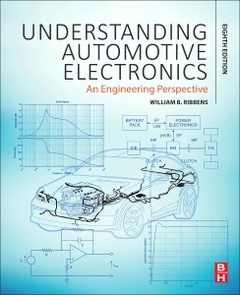Description
Understanding Automotive Electronics (8th Ed.)
An Engineering Perspective
Author: Ribbens William
Language: English
Subjects for Understanding Automotive Electronics:
Support: Print on demand
Description
/li>Contents
/li>Readership
/li>Biography
/li>Comment
/li>
Understanding Automotive Electronics: An Engineering Perspective, Eighth Edition, is written with an engineering perspective that includes mathematical models, providing a qualitative explanation of each subject that requires no mathematical background.
Thoroughly updated throughout, this new edition moves away from introductory mechanic-level electronics to cover hot topics such as automotive camera systems and typical electronic camera systems, hybrid control, AUTOSAR (AUTomotive Open System ARchitecture) and vehicle networks. Comprehensive coverage of automotive electronics and control, including the latest technology in telematics, active safety, entertainment, and communications are also included.
This book is the first port of call for control engineers, system engineers, and electronic engineers in automotive who need a thorough grounding in automotive electronics and control. From simple automotive electronic circuits, to the latest developments in telematics, active safety, entertainment, and communications, the book is also an ideal resource for more senior automotive engineers without a background in electronics or control who to work in the area or supervise specialists.
1. Survey of book technology2. Electronic Fundamentals3. Microprocessors4. Engine control basics5. Sensors and actuators6. Practical power train control7. Motion control8. Instrumentation9. Vehicle communications10. Safety related systems11. Diagnostics12. Autonomous vehicles
Control and system engineers, technicians and electrical engineers entering the automotive field. Senior engineers without electronics/ control background supervising specialists. Undergrads studying Electronics, Automobile and Grad Students in Embedded & real-Time Systems, Applied Electronics, Automobile Engineering
- Presents the full range of electrical/electronic theory that is applicable to modern automotive technology at a level progressing from basic theory and science, to detailed application to all major automotive systems and components
- Features circuit diagrams that are representative of actual circuits used to perform relevant functions in automotive electronic systems
- Discusses how the AUTOSAR middleware platform integrates with the low level electronics of automotive systems
- Provides a thorough understanding of automotive electronic technology at a level that is helpful to students, technicians, and industry engineers




